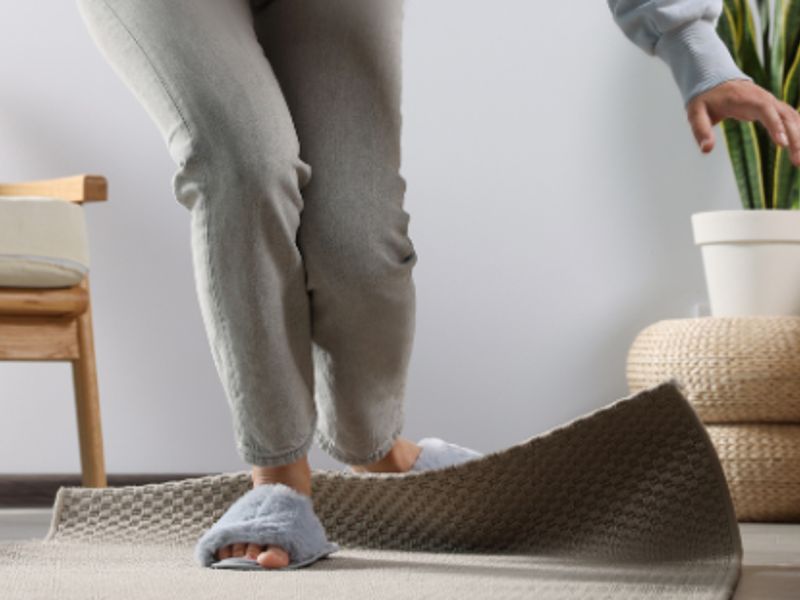
Fall Prevention: The Importance of Appropriate Flooring
When it comes to fall prevention, identifying and addressing trip hazards in the home is a crucial first step. Having the right flooring matters, as uneven surfaces may pose a significant risk to trips and falls.
Why Flooring Matters to Avoid Trip Hazards
When it comes to fall prevention for the elderly, identifying and addressing trip hazards in the home is a crucial first step. Uneven flooring, loose carpets, or area rugs pose significant risks for trips and slips, which makes this relevant and essential to assess, as a way of creating a living space that prioritises safety.
The Significance of Level Flooring
As we age and our gait may become less steady, the importance of having level flooring cannot be overstated, as the smallest of uneven surfaces can become a potential stumbling block, which may lead to falls and severe injuries injuries. A level floor without trip hazards is the foundation for fall prevention, and is one of the first things to assess, to ensure we can to move confidently and safely around our homes.
The Danger of Area Rugs
Area rugs are common culprits when it comes to trip hazards. While they may add comfort and aesthetics to a room, they can easily become a trip hazard as the edges of loose rugs can curl, and create an unexpected obstacle in the path of someone with limited mobility. Additionally, one may catch a foot on the carpet's edge, leading to a potentially dangerous loss of balance. Depending on an area rug's backing, they may also slip around, causing a slip hazard.
1. The safest option is usually to remove loose rugs to ensure an even and level floor space, in particular in hallways and high traffic areas.
2. If the rugs need to stay, securing rugs is a simple yet effective way to reduce the trip hazard. Consider using double-sided tape, or quality non-slip rug pads, to keep rugs in place.
These affordable solutions provide an extra layer of security, reducing the likelihood of trips, slips and falls. Regularly check the edges of rugs to ensure they remain secured, making adjustments as needed.
3. When looking at purchasing a rug, choose a low pile, high quality rug that is less likely to curl up, and is low enough to not create a big height difference. If it doesn't have non-slip backing, add the above solutions underneath.
Choosing Appropriate Flooring Materials
Selecting the right flooring materials is another key aspect of fall prevention:
1. Opt for materials that offer a smooth and level surface, as this will help minimising the risk of falls. Hardwood, laminate, or vinyl flooring, for instance, are excellent choices for maintaining a flat and stable foundation. Avoid materials with uneven textures or height variations which can become a potential trip or slip hazard.
2. Tiles should generally be avoided as they can become slippery and are also very hard should there be a fall, and may therefore cause more severe injuries.
3. It's advisable to steer clear of patterns and materials that reflect light, as these can lead to visual distractions, particularly as our eyesight deteriorates with age. This can result in uncertainty about where to place one's feet, potentially increasing the risk of falling.
4. It's commonly advised to contrast the colour of the floor with that of the walls, as this improves the visual distinction between them, making it clearer where surfaces change.
5. When using mobility aids like walkers or wheelchairs, carpets can significantly restrict manoeuvrability, making hard flooring the preferable choice. Even if mobility aids are not currently needed, it may be worth while to future-proof for potential equipment needs, opting for smooth flooring.
6. When selecting new flooring, it's worth to consult flooring specialists and/or an Occupational Therapist, as they can assist with determining the most suitable option for fall prevention, taking any current or future mobility needs into consideration.
7. Regularly inspect the conditions of all flooring, in particular in high-traffic areas, such as hallways and living rooms, to identify and address any irregularities promptly. Scheduling a regular time for this may be worthwhile, e.g. in conjunction with daylight savings.
Conclusion
Ensuring even flooring and securing area rugs are pivotal in creating a home environment that prioritises the safety of our ageing loved ones. By taking proactive measures, such as securing rugs and selecting appropriate flooring materials, we can significantly reduce the risk of falls, allowing our loved ones to navigate their homes confidently and independently.
Stay tuned for more insights on fall prevention in our upcoming posts.
The content on this website does not constitute professional advice. The information provided is for general informational purposes only. For specific and personalised advice, particularly in areas such as health, finance, or legal matters, we recommend consulting with a qualified professional in the relevant field.
We use affiliate links which means we may earn a small commission if you purchase through these links. The commission comes at no additional cost to you and helps support the maintenance and upkeep of this site.

As one ages, it does not necessarily mean losing independence or having to leave your home. We're here to share tips and tricks for creating a sustainable home environment and habits to age safely in place; Safe at Home.